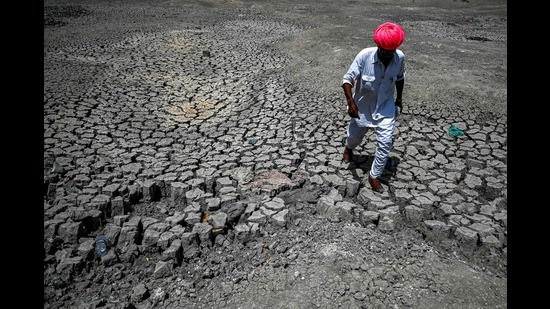Heatwaves are here to stay. Adapt fast
Human-caused climate crises are causing heat extremes to increase dramatically, with dire consequences for society. What this needs is an acknowledgement of the link to the climate crisis, and faster rates of adaptation
Extreme heat has held large parts of South Asia in its grip since the beginning of March, removing spring from the seasonal calendar. March was the hottest in India since records began to be kept 122 years ago, with temperatures consistently 3°C-8°C above average, breaking many decadal and some all-time records in several parts of the country, including the western Himalayas, the plains of Punjab, Haryana, Delhi, Rajasthan and Uttar Pradesh. The heat was combined with below-average rainfall, leading to the country’s wheat-growing regions losing much of their harvest. At least 3,000 wildfires scorched the country, which meant Delhi recorded the worst air quality ever seen in April.

Heatwaves are not uncommon in South Asia, but this one started so early, when people and fields were not prepared, and it lasted much longer than heatwaves usually do. Some short-term relief apart, probably only the beginning of the monsoon season will truly break this exceptionally strong grip of heat.
But is it that exceptional anymore? A few days ago, the World Meteorological Organization (WMO) said, “It is premature to attribute the extreme heat in India and Pakistan solely to climate change but it is consistent with what is expected in a changing climate.” But WMO’s framing is dangerously outdated.
This isn’t just a hot summer in South Asia that’s hitting poor people hard. It affects the whole world, more and more often, in areas where temperatures of almost 50 degrees Celsius were unthinkable until a few years ago and considered statistically extremely improbable (think of Canada last summer).
That heat records are being broken is nothing new. We’ve known for a long time that this would happen in a warming world — we’ve seen it, we’re seeing it now and will continue to see it until we stop burning fossil fuels.
But, despite this knowledge, many reports on this heatwave are hesitant to point out this connection. The WMO should know better; and not use the same phrasing it used 20 years ago: “It’s what we expect with increasing warming, but we can’t attribute this [to a] single heatwave…..” Yes, we can. Science has shown that every heatwave we experience is now becoming more intense due to human-caused climate crisis. Every single one. Including those in South Asia.
It is certain that the most dramatic changes in extreme weather from human-caused climate crises are in the rate and intensity of hot and cold extremes. Cold extremes are declining while heat extremes are increasing dramatically, with dire consequences for society. With my team, we published on Monday what this means in numbers: The very long and early heatwave – and this is still relatively rare – is a one in 100-year event, in today’s world of 1.2C of global warming. Without this additional warming, it would have been truly exceptional as a one in 3,000-year event.
Heatwaves are a silent killer. People rarely fall down dead on the street, but die quietly in their poorly insulated and unairconditioned homes. When records are kept, these preventable deaths become a visible statistic months after the event. In most parts of the world, these statistics do not exist, making heatwaves, their increasing intensity, and their victims invisible. Everywhere where there are relatively reliable statistics, heatwaves are by far the deadliest weather events.
Even when we know their numbers, or even their names, we all too rarely discuss the impact of the climate crisis. Flood risks and storm surges have direct economic costs that can be factored into insurance premiums and have thus become increasingly important to the financial sector. However, heatwaves are not mentioned in either finance or insurance because their economic costs are more difficult to estimate. But it’s heatwaves that are by far the most brutal manifestations of the climate crisis.
But what we need to talk about is not how much this event has been made more likely already. The climate crisis hasn’t stopped; emissions globally are not only not decreasing, but still increasing. This means this is not the hottest event we have seen, nor the longest or the most frequent. In fact, that the heatwave we’re just observing has been made so much more likely since pre-industrial times is of little consequence for knowing what we need to prepare for. As long as emissions are continuing to increase, the rates of heatwave severity will increase.
The real question we all need to ask: How can this be met by equally fast rates of adaptation and when are our limits reached? I don’t have an answer, but communities deserve one.
Dr Friederike Otto is senior lecturer, Grantham Institute for Climate Change, Imperial College London. She leads the World Weather Attribution Initiative, which assesses the role of climate change in extreme weather eventsThe views expressed are personal
All Access.
One Subscription.
Get 360° coverage—from daily headlines
to 100 year archives.



HT App & Website






